





























MIDWEEK UPDATE 29 JANUARY 2020



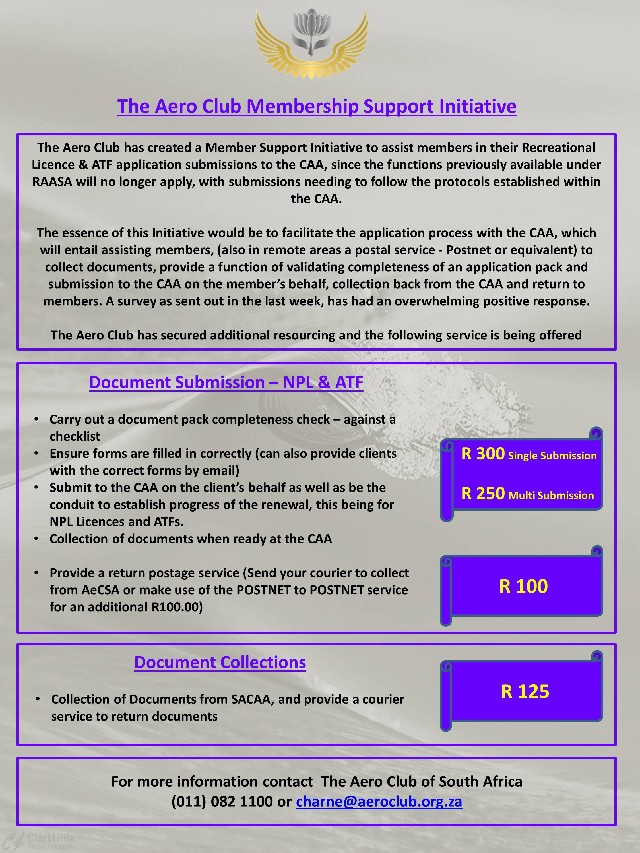


31 to 1 Feb: Witbank Speed Rally and 2nd Grand Prix Section - Witbank Airfield. Contact Rob Jonkers Contact chairman@sapfa.co.za Tel: 082 804 7032 or Jonty Esser at jonty@promptroofing.co.za Tel: 082 855 9435 Please enter online at www.speedrally.co.za



7 - 9: SAPFA Committee Bosberaad - Paddafontein. Contact: rob@aerosud.co.za Cell: 082 804 7032
8: EAA Chapter 322 Breakfast Fly away to Rustenburg.
29: Rally Navigation Training Course - Venue Aerosud. Contact: Mary de Klerk e-mail: maryd@expandingbranding.co.za cell: 084 880 9000


7: Brakpan Fun Rally - Brakpan Airport - Contact: Frank Eckard e-mail: frank.eckard@mweb.co.za cell: 083 269 1516
7-8: SAC KZN Regional Aerobatics. Ladysmith Airfield. Contact Annie Boone: chunge@mweb.co.za
21: Bethlehem Speed Rally - Bethlehem Airfield - Contact: Jonty Esser e-mail: jonty@promptroofing.co.za cell: 082 855 9435
21: The Airplane Factory Fly-in, Tedderfield. Contact: Shanelle 011 948 9898
21-22: Fashkosh Airshow Stellenbosch Airfield. Contact: Anton Theart at gm@stelfly.co.za or 079 873 4567
13 to 5 April: Sun 'n Fun, Lakeland Florida USA. Contact: Neil Bowden at Neil1@telkomsa.net or on 084 674 5674


4: Robertson fly-in breakfast. Contact Alwyn du Plessis 083 270 5888
3 - 5: Groblersdal Flying Club fly-in. For more information contact Richard at 082 490 6227 or flybenchmark@gmail.com
2 - 4: SAPFA Rally Nationals & Fun Rally - Stellenbosch Airfield. Contact Frank Eckard e-mail: frank.eckard@mweb.co.za cell: 083 269 1516
4: Wings and Wheels Festival at Uitenhage airfield. Contact Lourens Kruger E-mail: lmk@telkomsa.net Cell: 082 320 2615
18: Heidelberg Airshow. Contact Franz van Zyl 082 560 2275
18: Aero Club of South Africa Centenary Banquet venue TBA. Contact Marie Reddy E-mail: marie.reddy@gmail.com Cell: 083 259 7691
21: Aero Club of South Africa Annual General Meeting EAA Auditorium Rand Airport. Contact Sandra Strydom E-mail: sandra@aeroclub.org.za Tel: 011 082 1100
24 -25: Garden Route Airshow Brett Scheuble brett@gardenrouteairshow.co.za 084 418 3836
30 to 3rd May: 2020 Aero Club Airweek - Middelburg Airfield - Contact Rob Jonkers e-mail: rob@aerosud.co.za cell: 082 804 7032


EASA DRAFTING CERTIFICATION PLANS FOR EVTOL PROTOTYPES IN EUROPE
This proposal will outline the critical regulations and rules eVTOL manufacturers must adhere to in achieving type certificates. It is expected as the technology advances towards commercialization that newer regulations will emerge sometime later this year, likely mid-November. For now, these basic regulations will likely follow the framework of existing air transport rules.
David Solar, head of VTOL certifications for EASA has stated that aerial mobility manufacturers are eager to receive the proposal sooner rather than later as to limit design re-work that may be necessary to achieve a type rating in EASA's jurisdiction. However, Solar warns, "The first crash of an eVTOL aircraft could kill the business, so it's important that we learn but do not close the door to progress."
"The plan is that over the next couple of years, or more, we will see if we are aligned with what the applicants eVTOL manufacturers are doing," Solar said. "At some point, it may result in a new CS regulation, or a change in the regulatory framework, it is hard to predict exactly when this will be completed because the industry is going through a lot of prototypes now with many final designs still on the drawing board."
Along with the design requirements, EASA will publish rules and regulations surrounding the operation of eVTOL aircraft. In the context of urban air mobility operations, Solar said he expects individual cities to also establish the terms under which they are willing to accept operations.


For the TBM very fast turboprop aircraft, deliveries continued to be focused in the U.S., involving 38 airplanes; followed by Europe, with three in Germany, two in the United Kingdom and one in Russia. Daher provided three TBMs in Latin America: two for customers in Brazil, and one in Mexico. Completing the 2019 activity was a TBM 940 version delivered in Japan, marking the first sale of a TBM in this country since the acquisitions of several TBM 700s by Japanese customers during the TBM program's early days.
With Daher's addition of Kodiak to its aircraft portfolio last year, the 2019 sales results were the first to include both the Kodiak and TBM in the company's annual tally of new business.


EAA officials note there are "many legitimate safety concerns" surrounding drones, primarily those that are airborne camera platforms capable of flying beyond visual line-of-sight with little or no training by the operator.
"But traditional modelling has been operating trouble-free for nearly the entire history of manned flight," they continued. They warn that model aircraft aren't the only ones that may be impacted by the proposed rule.
After carefully reading the NPRM and consulting with partners in the model aircraft community, EAA officials say these are their top concerns with the proposed rule:
This rule is based on an imagined security and safety threat that simply is not proven in relation to traditional modelling. There is absolutely a risk posed by drones operated in proximity to aircraft by poorly informed, careless, and/or deliberately malicious operators, but the same cannot be said for models.
The rule would require every modeler to uniquely register every aircraft they own. Models come and go from modelers' collections on a regular basis, which would necessitate frequent changes to the registry. A prolific modeler could easily own more than 100 models - a truly unwieldy number to maintain valid registrations, especially if there is a per aircraft fee involved.


The H125 will be displayed with the company's latest improvements destined to better serve aerial work operations. Following the success of Airbus Corporate Helicopters (ACH) since its launch in 2017 as the dedicated Private & Business Aviation helicopter platform, particularly with the ACH145 and ACH160, Airbus has renewed its offer for the ACH130 by partnering with Aston Martin, the epitome of automotive art.
The H175 on the booth will be displayed in an offshore transportation configuration. In addition, an H160 immersive experience will highlight the helicopter's breakthrough innovations in three of its major missions - offshore transportation, private and business aviation, emergency medical services as well as its digital support concept.
Committed to accompanying customers long after an aircraft is first delivered, Airbus will present its latest selection of support and service enhancements at the HCare corner, where visitors can learn more about the new online customer portal, digital services, analytics, training, and HCare global contracts. These offers, among others, enable customers to increase availability and mission success, optimise their costs, lower the maintenance burden, enhance safety and sustain the value of their assets.
In addition, the Airbus Helicopters static display, adjacent to the booth, will feature an AS332 from Heli Austria in a firefighting configuration, an H125 from Brainerd Helicopters in an aerial work configuration and an H125 from LAPD in a law enforcement configuration, an H145 from San Diego Gas & Electric, and last but not least, the Vahana demonstrator, having just completed its flight test campaign. On the flight line at Heli-Expo, customers can experience a demo in an H125 equipped with the new Garmin TXi TM avionics, an H135, and an ACH130 with a bespoke interior.


Launched just over five years ago, in November 2014, the entry into service milestone marks yet another successful achievement for the internal aircraft programme that was awarded Type Certification by the European Aviation Safety Agency (EASA) in November 2019, following an intensive flight test campaign that saw the BelugaXL complete more than 200 flight tests, clocking over 700 flight hours.
At 63 metres long and 8 metres wide, the BelugaXL has the largest cargo bay cross-section of all existing cargo aircraft worldwide. The BelugaXL can carry two A350 XWB wings compared to the BelugaST, which can only carry one. With a maximum payload of 51 tonnes, the BelugaXL has a range of 4,000 km. (2200nm).
The BelugaXL is based on an A330-200 Freighter, enabling the re-use of existing components and equipment, and is powered by Rolls-Royce Trent 700 engines. The lowered cockpit, the cargo bay structure and the rear-end and tail were newly developed jointly with partners, giving the aircraft its distinctive look.
The BelugaXL is the latest addition to Airbus' transportation portfolio. While air transport remains the primary method for transporting large aircraft components, Airbus also uses road, rail and sea transport to move parts between its production sites. Like the BelugaST, the aircraft will operate from 11 destinations in Europe, continuing to strengthen industrial capabilities and enabling Airbus to deliver on its commitments.

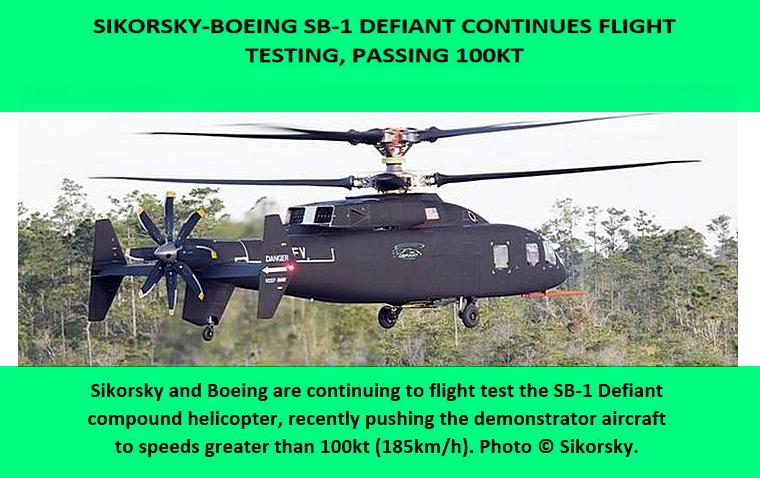
"The Sikorsky-Boeing SB-1 Defiant continues to expand its flight envelope through sorties each week, executing the mission elements required for Future Vertical Lift, most recently exceeding 100kt and performing manoeuvres at 30į angle of bank at the Sikorsky Development Flight Test Centre in West Palm Beach, Florida. At the NASA Ames Research Centre, a subscale Defiant model has been successfully tested at 250kt." the companies said.
The Sikorsky-Boeing team said in October 2019 they planned to increase the SB-1's speed during test flights in 40kt increments until reaching 230kt by the end of the first quarter in 2020.
The SB-1's chief competitor, the Bell V-280 Valor tiltrotor, had accumulated more than 150 hours of flight time over two years as of December 2019. Sikorsky and Boeing did not disclose how many hours the Defiant demonstrator had logged.

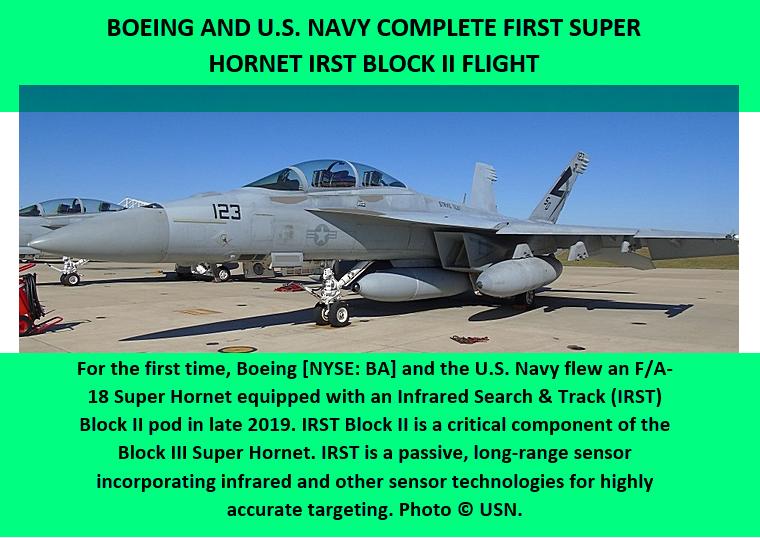
"The IRST Block II sensor gives Navy fighters extended range and increasing survivability. This technology will help the Navy maintain its advantage over potential adversaries for many years," said Kenen Nelson, Lockheed Martin Director of Fixed Wing Programs, supplier of the IRST sensor.

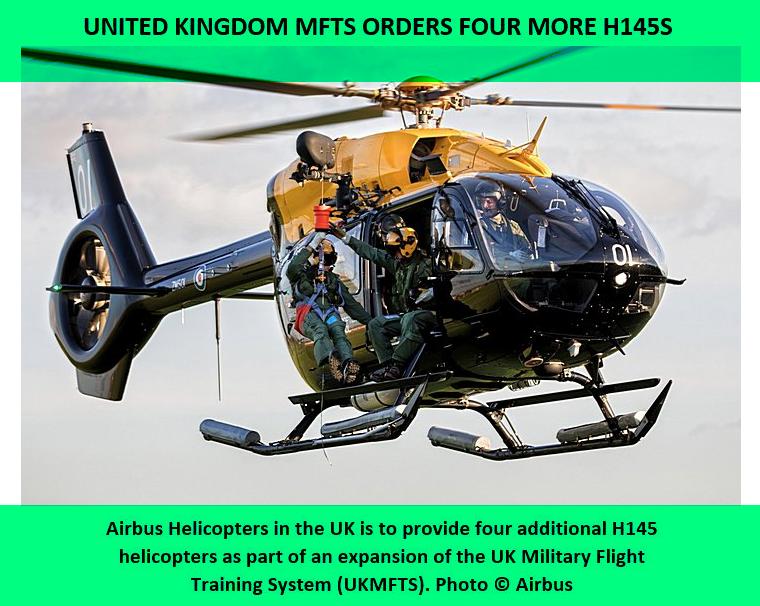
The new helicopters will join the existing fleet of 29 H135s and three H145s, known respectively as Juno and Jupiter in UKMFTS service. They will be delivered during 2020.
Operated by Ascent Flight Training Management Ltd primarily from RAF Shawbury and also RAF Valley on behalf of the Ministry of Defence, the aircraft are used to train all UK military helicopter pilots and rear crew.
Airbus Helicopters is fully embedded at both bases as the rotary wing aircraft service provider to Ascent.
Managing director of Airbus Helicopters in the UK, Colin James, said: "The H135 Juno and H145 Jupiter are demonstrating day-in and day-out their exceptional reliability and versatility in the training role at UKMFTS. It's deeply satisfying for us to see the first aircrew having already graduated and we look forward to delivering the additional aircraft in the very near future."
The H145 helicopter family has completed more than 5.5 million flight hours worldwide with more than 1,300 aircraft in the global fleet.


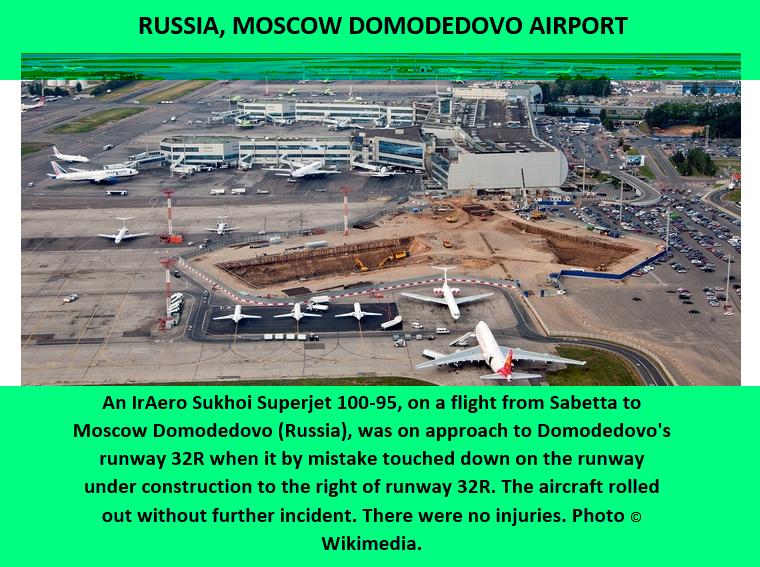
Turkey, Antalya: A Nordwind Airlines Airbus A321-200 on a flight from Moscow Sheremetyevo (Russia) to Antalya (Turkey), touched down hard on the runway. The crew initiated a go-around and observed attitude and navigation indication problems were observed by the crew and smoke started entering developed in the cockpit. Donning their oxygen masks, they declared MAYDAY and performed a low approach to have the underside of the aircraft including landing gear inspected for any structural issues. While climbing out after the low approach both main hydraulic systems failed. The crew declared Mayday a second time and performed a visual approach and landing. The aircraft was unable to vacate the runway. A post flight inspection showed both nose gear tyres deflated, the nose gear strut had been pushed through the cabin floor, the fuselage, all in the area of the nose gear, showed significant creases.
USA, Alaska Unalaska Airport: A Beechcraft King Air, medevac ambulance with three on board operated by LifeMed Medevac crashed while taking off from Unalaska's airport, a major fishing port city in Alaska's Aleutian Island. The aircraft ended up in the ocean between the end of the runway and Hog Island in Unalaska Bay. The three people on board were picked up by a city harbour vessel and taken to the Iliuliuk Family and Health Services Clinic. No serious injuries were reported.
Australia, NSW Snowy Mountains: A Lockheed EC-130Q Hercules operated by Coulson Aviation with three on board crashed while firefighting. There were no survivors and the aircraft was damaged beyond repair.



Henry Harley "Hap" Arnold (25 June 1886 - 15 January 1950) was an aviation pioneer and the only U.S. Air Force general to hold five-star rank as well as the only officer to hold a five-star rank in two different U.S. military services, General of the Army and General of the Air Force.
Arnold entered the United States Military Academy at West Point having just turned 17. However, he disliked infantry troop duties and volunteered to assist Captain Arthur S. Cowan of the 20th Infantry, who was on temporary assignment in the Philippines mapping the island of Luzon. Cowen was assigned to recruit two lieutenants to become pilots and he contacted Arnold.
In 1911 Arnold saw his first airplane in flight and on 21 April 1911 sent a letter requesting a transfer to the Signal Corps. He was accepted and started flight training at Dayton, Ohio on a Wright Model B airplane. After several weeks of solo flying in Dayton, Arnold and Milling were send to the Aeronautical Division, Signal Corps station established at College Park, Maryland, to be the Army's first flight instructors
There Arnold set an altitude record of 3,260 feet (990 m) on 7 July 1911 and thrice broke it (18 August 1911, to 4,167 feet (1,270 m); 25 January 1912, to 4,764 feet (1,452 m); and 1 June 1912, 6,540 feet (1,990 m)).
In October, Arnold and Milling were ordered to enter the competition for the first MacKay Trophy for "the most outstanding military flight of the year." Arnold won when he located a company of cavalry from the air and returned safely despite high turbulence. As a result, he was sent to Fort Riley, Kansas, to experiment with radio and other communications from the air with the field artillery. Arnold's flight on 2 November in a Wright C Speed Scout S.C. No. 10, with 1st Lt. Follett Bradley as his wireless operator, successfully sent the first radio telegraph message, at a distance of 6 miles (9.7 km), from an aircraft to a receiver on the ground.
Arnold had an illustrious career during both world wars. He passed away on 15 January 1950, at his home in Sonoma.

 |
 |
 Copyright © 2024 Pilot's Post PTY Ltd
The information, views and opinions by the authors contributing to Pilotís Post are not necessarily those of the editor or other writers at Pilotís Post.
Copyright © 2024 Pilot's Post PTY Ltd
The information, views and opinions by the authors contributing to Pilotís Post are not necessarily those of the editor or other writers at Pilotís Post.